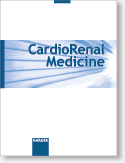 |
 |

Welcome to the 1st issue of Kidney and Blood Pressure Research Digest (KBPR Digest) in 2011. We would like to draw your attention to articles of outstanding importance in the field of nephrology and hypertension, presenting short summaries of these articles to the scientific community in the form of KBPR Digest.
KBPR Digest provides readers from all over the world with a free and concise overview on interesting topics which are part of the current issue of Kidney and Blood Pressure Research. We hope that you will be inspired to get to know more about the articles which are presented below.


Professor Thomas Quaschning, MD, PHD
On behalf of the Editorial Board of Kidney and Blood Pressure Research
mail@thomas-quaschning.de

|
 |
Digest of issue 1/2011
|
 |
Issue 1/2011 of Kidney and Blood Pressure Research covers a wide spectrum of clinical and preclinical topics: It contains a study which estimates markers of oxidative stress in chronic kidney disease as well as a review article highlighting the interplay between high salt diet, the renin-angiotensin-system and hypertension. Furthermore, the issue contains a study which evaluates the impact of resistant hypertension in patients with chronic kidney disease.
|
 |
Oxidative stress is known to be involved in many human pathological processes, such as hypertension, atherosclerosis and neurological disorders. Much evidence shows that chronic kidney disease (CKD) is also associated with increased oxidant production and decreased antioxidant defenses. It has been suggested that oxidant-antioxidant imbalance is one of the major causes of increased risk of atherosclerosis and cardiovascular disease in patients with chronic renal failure. Changes mediated by oxidative stress are thought to be involved with atherosclerosis in patients with CKD. The purpose of this Polish study (Kidney Blood Press Res 2011;34:12-19) was to analyze the markers of oxidative damage and the activity of antioxidative enzymes as well as the total antioxidant capability in patients with different stages of CKD, both conventionally treated and dialyzed. The authors evaluated the oxidative modification of lipids (by oxidized low-density lipoprotein and malonodialdehyde levels) and proteins (by advanced oxidation protein product levels). The activity of paraoxonase-1 and glutathione peroxidases and total antioxidant status were also assessed. Compared with the control group, the uremic patients, both dialyzed and nondialyzed, had higher levels of all studied plasma oxidative stress markers and decreased activity of antioxidative enzymes. The authors concluded that oxidative stress seems to be related rather to the uremic state than to the dialysis treatment. They furthermore showed that estimating total antioxidant status in a simple test is unreliable for assessing the antioxidant ability of patients with CKD.
|
 |
High-salt diet is one of the major risk factors in the development and maintenance of hypertension. Numerous experimental and observational studies have confirmed the association of sodium intake with blood pressure levels. The effects of a high-salt diet are related to the function of the renin-angiotensin system, which is normally suppressed by a high-salt diet. Endothelial dysfunction probably plays an important role in the influence of high sodium intake on blood pressure, although the exact mechanisms remain elusive. Genetic factors are known to be very important, and various consomic and congenic rat strains as animal models have proven to be very useful in bringing us a step closer to understanding the interaction between salt intake and hypertension. In their compelling review (Kidney Blood Press Res 2011;34:1-11), Drenjancevic-Peric and colleagues analyzed and commented experimental data obtained in studies on animals and humans, as well as epidemiological data. The causes of essential hypertension are still unknown despite the investigative efforts of scientists worldwide. Results of previous studies suggest that mutations in the renin gene (or other genes that encode components of the RAS) could be crucial in the development of hypertension and salt sensitivity. Besides the effects of high sodium intake on the RAS, endothelial dysfunction and sympathetic nervous system activity, there are other factors that cannot be disregarded as important contributors to the blood pressure increase linked to salt intake, including volume expansion (and elevated peripheral resistance in the later phase), functional changes of ion exchangers (such as the Na-Li countertransport) and polymorphism in transport proteins.
Better understanding of the mechanisms involved in the interaction of sodium intake and blood pressure will be essential for successful therapeutic interventions, and new insights into this issue represent a valuable means of controlling the aforementioned public health problems.
|
 |
The concept of resistant hypertension (RH) is clinically relevant even if the definition is somewhat arbitrary with regard to the number of antihypertensive medications required. The purpose of early detection and careful evaluation of patients with RH is in fact aimed to identify individuals who have secondary causes of hypertension who may benefit from specific therapeutic considerations. This point is critical since prognosis of this condition is supposed to be poor. The latter concept holds particularly true in CKD, which constitutes a major cause of hypertension and it is characterized by a well-defined cardiorenal risk from stages as early as CKD 1 or 2. The present study of De Nicola and colleagues (Kidney Blood Press Res 2011;34:58-67) is the first to provide information regarding the burden of RH in CKD patients. The authors evaluated frequency, correlates and prognosis of RH in 300 consecutive incident hypertensive CKD patients in an academic renal clinic. The CKD cohort examined was characterized by a high prevalence of advanced age, overweight, diabetes, LVH and significant history of CV events.
RH was defined as office blood pressure (BP) greater or equal 130/80 mm Hg despite 3 or more drugs at full dose including a diuretic, or as BP at goal with 4 or more full-dose drugs. Patients were evaluated at referral and after 6 months of nephrological management; thereafter, they were included in a renal survival analysis lasting 37.6 months. Diabetes and proteinuria predicted the incidence of RH at month 6. Presence of RH at month 6 was associated with greater risk of renal death, independent of main clinical features and degree of BP control.
The authors conclude that in hypertensive CKD patients, intensification of antihypertensive therapy allows to properly reveal the frequency of RH. Identification of RH is clinically meaningful as this condition is associated with poor renal survival independent of BP control. The present data should help to design randomized trials aimed at assessing in CKD patients with RH the effectiveness of salt restriction and other alternative therapeutic interventions that have been proven to be efficacious in reducing the burden of RH in non-CKD patients.
|
 |
For submission of articles or sign-ups to ToC Alerts, please go to the journal's homepage
|
 |
New journal
|
 |

Register your free online access for 2011
This new journal, edited by James. R. Sowers and his team, provides an interdisciplinary platform for the latest advances in cardiorenal research, with special focus on the cardiorenal metabolic syndrome. The first issue includes a classification of the cardiorenal syndrome, as well as several reviews and original papers on topics of special interest.
|
 |

Cardiorenal Medicine
2011: Vol. 1 with 4 issues
Language: English
ISSN: 1664-3828
e-ISSN: 1664-5502
|
|
|
 |

© S. Karger AG - Medical and Scientific Publishers
Allschwilerstrasse 10, P.O. Box, CH-4009 Basel (Switzerland)
Tel. +41 61 306 11 11, Fax +41 61 306 12 34, publications@karger.com.

|
|
 |
 |
 |
Please read the Karger Privacy Policy. If you have received this email by mistake, click here and we will take you off this mailing list.
 |
 |
|

